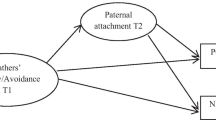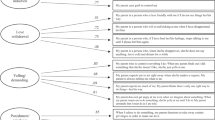Abstract
Inner compass (IC) is a schema composed of values, interests and goals that can guide the individual to make life choices that are congruent with their authentic self and basic needs. Past research has shown that having an IC predicts adolescents’ optimal functioning, contributing to positive outcomes such as identity formation, resilience against negative peer influences, and well-being. The current research explored the role of parents on Chinese adolescents’ having an IC. Specifically, we hypothesized that children were more likely to have an IC if their parents (1) demonstrated inherent values (IVD) in their behavior to children, (2) supported an open exploration and examination of values (SVE) in children, and (3) fostered an inner valuing (FIV) in their children based on authentic values and interests, especially when confronted with difficult situations and social pressure. We also hypothesized that attachment avoidance may attenuate the parenting effects, especially for FIV and SVE, which are more direct parental influences. Results supported our hypothesis, showing significant positive effects of all three parenting styles on having an IC, and that these effects were weaker when children have high attachment avoidance with parents. The current research contributes to the integration of attachment theory and self-determination theory.


Similar content being viewed by others
Notes
According to factor analysis research (e.g., Marsh et al. 2009; Muthén & Asparouhov 2012), traditional independent-cluster factor analysis model is overly strict. It is very commonly expected in CFA models that the covariances between items cannot be solely explained by the underlying substantive factors; other exogenous variables, such as wording similarity, may also lead to covariance patterns that cannot be explained by the substantive factors. In fact, Correlated residuals (between items of the same construct) are one of the most common modifications to CFA models (Brown 2014). When reasonable, it is not only acceptable, but actually necessary to estimate these correlated errors, because it leads to more accurate CFA solutions (Brown 2014). In our case, modification indices indeed pointed to additional correlations between several residuals of items under the same parenting scale. For example, the highest modification index for residual correlation was between the first item (“My parents have values and goals that are really important to them”) and the second item (“There are values and morals my parents really care about”) of IVD: χ2 = 110.81. These two items both ask about parental IVD that manifest in the realm of values. Therefore, we freed up these within-subscale residual correlations.
References
Ainsworth, M. D., Blehar, M. C., Waters, E., & Wall, S. (1978). Patterns of attachment: Assessed in the strange situation and at home. Hillsdale: Erlbaum.
Assor, A. (2012). Allowing choice and nurturing an inner compass: Educational practices supporting students’ need for autonomy. In S. L. Christenson et al. (Eds.), Handbook of research on student engagement (pp. 421–439).
Assor, A. (2018). The striving to develop an authentic inner-compass as a key component of adolescents’ need for autonomy: Parental antecedents and effects on identity, well-Being, and resilience. In B. Soenens, M. Vansteenkiste, & S. Van Petegem (Eds.), Autonomy development in adolescence. London: Psychology Press in conjunction with European Association for Research on Adolescence (EARA).
Assor, A., Cohen-Melayev, M., Kaplan, A., & Friedman, D. (2005). Choosing to stay religious in a modern world: Socialization and exploration processes leading to an integrated internalization of religion among Israeli Jewish youth. Advances in Motivation and Achievement, 14, 105–150.
Beyers, W., Soenens, B. & Assor, A. (2016). Beyond commitment making: How can parents support adolescents’ and emerging adults’ inner compass? Paper presented at the Society for Research on Adolescence Biennial Meeting, Baltimore, USA. Retrieved from: https://www.vopspsy.ugent.be/pdfs/download.php?own=wbeyers&file=Beyers_Soenens__Assor_SRA2016.pdf
Bowlby, J. (1969/1982). Attachment and loss: Vol. 1. Attachment (2nd ed.). New York: Basic Books (original work published 1969).
Brambilla, M., Assor, A., Manzi, C., & Regalia, C. (2015). Autonomous vs. controlled religiosity: Family and group antecedants. The International Journal of Psychology of Religion, 25(3), 193–210.
Brenning, K., Soenens, B., Braet, C., & Bosmans, G. (2011). An adaptation of the experiences in close relationships scale-revised for use with child and adolescence. Journal of Social and Personal Relationships, 28(8), 1048–1072.
Brenning, K., Van Petegem, S., Vanhalst, J., & Soenens, B. (2014). The psychometric qualities of a short version of the Experiences in Close Relationships Scale–Revised Child version. Personality and Individual Differences, 68, 118–123.
Bridges, L., Frodi, A., Grolnick, W. S., & Spiegel, N. H. (1983). Mothers’ styles and mother–infant attachment patterns. Unpublished manuscript, University of Rochester, Rochester, NY.
Brown, T. A. (2014). Confirmatory factor analysis for applied research. New York: Guilford Publications.
Cohen, G. L., & Sherman, D. K. (2014). The psychology of change: Self-affirmation and social psychological intervention. Annual Review of Psychology, 65, 333–371.
Cohen-Malayev, M. (2009). Religious exploration and identity – The tension between religion and religiosity: Examination of the internalization process of Jewish religious values in modern-orthodox context. Doctoral dissertation, Ben Gurion University, Be’er-Sheva, Israel.
Collins, N. L., & Feeney, B. C. (2004). Working models of attachment shape perceptions of social support: Evidence from experimental and observational studies. The Journal of Personality and Social Psychology, 87(3), 363–383.
Deci, E. L., & Ryan, M. R. (2000). The “what” and “why” of goal pursuits: Human needs and the self-determination of behavior. Psychological Inquiry, 11(4), 227–268.
Deng, Y., Chen, Y., Yue, Y., Hu, H., Huang, Y., & Liu, X. (2017). Reliability and validity test of short version of the experiences in close relationships scale for children in Chinese middle school students. Chinese Journal of Clinical Psychology, 25(6), 1022–1026.
Deng, Y., Yan, M., Chen, H., Sun, X., Zhang, P., Zeng, X., Liu, X., & Lye, Y. (2016). Attachment security balances perspectives: Effects of security priming on highly optimistic and pessimistic explanatory styles. Frontiers in Psychology, 7: 1269. https://doi.org/10.3389/fpsyg.2016.01269.
Goodwin, L. D., & Leech, N. L. (2006). Understanding correlation: Factors that affect the size of r. The Journal of Experimental Education, 74(3), 249–266. https://doi.org/10.3200/jexe.74.3.249-266.
Grusec, J. E. (2008). What is the nature of effective parenting? It depends. In M. Kerr, H. Stattin, & R. C. M. E. Engels (Eds.), What can parents do? New insights into the role of parents in adolescent problem behavior (pp. 240–257). West-Sussex: Wiley.
Ho, C., Bluestein, D. N., & Jenkins, J. M. (2008). Cultural differences in the relationship between parenting and children's behavior. Developmental Psychology, 44(2), 507–522.
La Guardia, J. G., Ryan, M. R., Couchman, C. E., & Deci, E. L. (2000). Within-person variation in security of attachment: A self-determination theory perspective on attachment, need fulfillment, and well-being. The Journal of Personality and Social Psychology, 79(3), 367–384.
Leak, G. K., & Cooney, R. R. (2001). Self-determination, attachment styles, and well-being in adult romantic relationships. Representative Research in Social Psychology, 25, 55–62.
Markus, H. R., & Kitayama, S. (2003). Models of agency: Sociocultural diversity in the construction of action. In V. Murphy-Berman & J. J. Berman (Eds.), Nebraska symposium on motivation (pp. 18–74). Lincoln: University of Nebraska Press.
Marsh, H. W., Muthe´n, B., Asparouhov, A., Ldtke, O., Robitzsch, A., Morin, A. J. S., & Trautwein, U. (2009). Exploratory structural equation modeling, integrating CFA and EFA: Application to students’ evaluations of university teaching. Structural Equation Modeling, 16, 439–476. https://doi.org/10.1080/10705510903008220.
Mikulincer, M., Shaver, P. R., Cassidy, J., & Berant, E. (2009). Attachment-related defensive processes. In J. H. Obegi & E. Berant (Eds.), Attachment theory and research in clinical work with adults (pp. 293–326). New York: The Guilford Press.
Muthén, B., & Asparouhov, T. (2012). Bayesian structural equation modeling: a more flexible representation of substantive theory. Psychological methods, 17(3), 313–335.
Overall, N. C., Simpson, J. A., & Struthers, H. (2013). Buffering attachment-related avoidance: Softening emotional and behavioral defenses during conflict discussions. The Journal of Personality and Social Psychology, 104(5), 854–871.
Patrick, H., Knee, C. R., Canevello, A., & Lonsbary, C. (2007). The role of need fulfillment in relationship functioning and well-being: A self-determination theory perspective. Journal of Personality and Social Psychology, 92(3), 434–457.
Ren, Z., Wang, D., Yang, A., Li, M., & Higgins, L. T. (2011). Implicit and explicit measures of adult attachment to mothers in a Chinese context. Social Behavior and Personality: An International Journal, 39(5), 701–712.
Rothbaum, F., & Trommsdorff, G. (2007). Do roots and wings complement or oppose one another?: The socialization of relatedness and autonomy in cultural context. In J. E. Grusec & P. Hastings (Eds.) The handbook of socialization. New York: the Guilford Press.
Ryan, R. M., & Deci, E. L. (2017). Self-determination theory: Basic psychological needs in motivation, development, and wellness. New York: Guilford Publications.
Soenens, B., Vansteenkiste, M., Lens, W., Luyckx, K., Goossens, L., Beyers, W., & Ryan, R. M. (2007). Conceptualizing parental autonomy support: Adolescent perceptions of promotion of independence versus promotion of volitional functioning. Developmental Psychology, 43(3), 633–646.
Soenens, B., Vansteenkiste, M., & Van Petegem, S. (2015). Let us not throw out the baby with the bathwater: Applying the principle of universalism without uniformity to autonomy-supportive and controlling parenting. Child Development Perspectives, 9(1), 44–49.
Van Petegem, S., Beyers, W., Brenning, K., & Vansteenkiste, M. (2013). Exploring the association between insecure attachment styles and adolescent autonomy in family decision making: A differentiated approach. Journal of Youth and Adolescence, 42(12), 1837–1846.
Yu, S., Assor, A., & Liu, X. (2015). Perception of parents as demonstrating the inherent merit of their values: Relations with self-congruence and subjective well-being. International Journal of Psychology, 50, 70–74.
Yu, S., Chen, B., Levesque-Bristol, C., & Vansteenkiste, M. (2016). Chinese education examined via the lens of self-determination. Advance online publication. Educational Psychology Review.
Yu, S., Levesque-Bristol, C., & Maeda, Y. (2017). General Need for Autonomy and Subjective Well-Being: A Meta-Analysis of Studies in the US and East Asia. Advance online publication. Journal of Happiness Studies.
Author information
Authors and Affiliations
Corresponding author
Ethics declarations
Conflict of Interest
On behalf of all authors, the corresponding author states that there is no conflict of interest.
Ethical Standards
All procedures performed in studies involving human participants were in accordance with the ethical standards of the institutional and/or national research committee and with the 1964 Helsinki declaration and its later amendments or comparable ethical standards.
Informed Consent
Informed consent was obtained from all individual participants included in the study.
Rights and permissions
About this article
Cite this article
Yu, S., Deng, Y., Yu, H. et al. Attachment avoidance moderates the effects of parenting on Chinese adolescents’ having an inner compass. Curr Psychol 40, 887–894 (2021). https://doi.org/10.1007/s12144-018-0007-4
Published:
Issue Date:
DOI: https://doi.org/10.1007/s12144-018-0007-4




